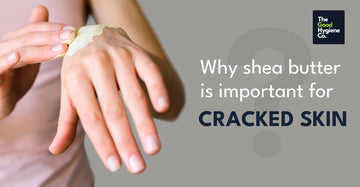Cracked skin isn't just a cosmetic issue — it's a sign that your skin barrier is compromised. Whether it's due to cold weather, excessive handwashing, or underlying skin conditions, cracked skin can be painful, inflamed, and vulnerable to infections. Fortunately, nature offers a powerful remedy: shea butter.
Rich, soothing, and nutrient-packed, shea butter for dry skin is one of the most effective natural treatments to restore moisture, reduce inflammation, and support skin healing. If you're dealing with cracked heels, chapped hands, or flaking elbows, shea butter might just be the skincare essential your routine is missing.
What is Shea Butter?
Derived from the nuts of the African shea tree (Vitellaria paradoxa), shea butter is a rich, ivory-colored fat traditionally used for centuries to protect and nourish the skin. What makes shea butter unique is its composition: it’s loaded with essential fatty acids, antioxidants, and healing compounds — all of which make it ideal for tackling severely dry and cracked skin.
Why Shea Butter is a Must-Have for Cracked Skin
1. Deeply Moisturizes and Locks in Hydration
Shea butter is a natural emollient, meaning it softens and soothes the skin by filling in the gaps between skin cells. But what sets it apart is its ability to lock in moisture, forming a breathable barrier over the skin. This barrier helps prevent further moisture loss, which is critical for cracked skin that struggles to retain hydration.
Whether you're applying it to cracked heels, hands, or lips, shea butter balm creates an instant cushion of moisture while allowing the skin underneath to heal.
2. Soothes and Calms Irritated Skin
Cracked skin often comes with redness, itchiness, and discomfort — signs of inflammation. Shea butter contains natural anti-inflammatory compounds such as cinnamic acid and lupeol, which help calm flare-ups. If you're dealing with eczema, psoriasis, or reactive dry patches, shea butter for skin offers much-needed relief without the harshness of synthetic ingredients.
3. Strengthens the Skin Barrier
A damaged skin barrier can no longer hold in moisture or keep irritants out. Shea butter helps restore this protective layer by reinforcing the skin’s natural lipids. This is essential not only for healing existing cracks but also for preventing further dryness and skin damage.
4. Nutrient-Rich Support for Skin Repair
Shea butter is a powerhouse of skin-loving nutrients. It’s rich in:
- Essential fatty acids (oleic, stearic, palmitic, linoleic acids) to replenish skin lipids
- Vitamin A to support cell turnover
-
Vitamin E, a potent antioxidant that helps prevent free radical damage
These nutrients not only nourish the skin but also promote healing and regeneration, making shea butter for cracked skin both restorative and preventive.
5. Helps Heal and Soften Cracks
Thanks to its thick, buttery texture and deep-penetrating properties, shea butter for dry skin is incredibly effective at softening hardened, cracked areas. With regular use, it reduces flaking, smoothens rough textures, and helps restore a supple, healthy feel to the skin.
Apply shea butter balm or moisturizer generously at night — especially on feet, hands, and elbows — and you’ll likely notice visible improvements by morning.
What Makes Shea Butter So Effective?
The key lies in its dual role:
-
It works like an emollient, smoothing over rough skin and filling microscopic cracks.
-
It also functions as an occlusive, locking in hydration while delivering anti-inflammatory, antioxidant-rich compounds deep into the skin layers.
This combination makes shea butter far more than just a moisturizer — it’s a healing treatment for skin in distress.
What’s Inside Shea Butter: Fats and Lipids that Heal
Shea butter is composed of approximately 60–70% fat, primarily made up of triglycerides and fatty acids that are crucial for repairing cracked skin. The key types of lipids in shea butter include:
- Oleic Acid: A monounsaturated fat that deeply penetrates and softens the skin.
- Stearic Acid: A saturated fat that gives shea butter its thick texture and helps reinforce the skin’s barrier.
- Linoleic Acid: An essential omega-6 fatty acid known for restoring skin barrier function and reducing inflammation.
-
Palmitic Acid: A saturated fat that enhances skin softness and acts as a protective layer.
These fats don’t just moisturize; they mimic the skin’s natural lipids, helping to repair cracks, strengthen the barrier, and retain hydration more effectively than many synthetic creams.
Best Ways to Use Shea Butter for Cracked Skin
-
As a Spot Treatment: Dab a small amount of shea butter balm on cracked knuckles, heels, or elbows for overnight healing.
-
Under Socks or Gloves: Apply generously and cover with cotton socks or gloves to seal in moisture while you sleep.
-
Post-Shower Moisturizer: Use shea butter immediately after bathing to trap moisture on damp skin and prevent dryness.
-
Layer Under Sunscreen: For exposed areas like the face or hands, layer shea butter under SPF to protect and hydrate simultaneously.
Shea Butter: A Gentle Option for Sensitive Skin
Unlike many commercial creams that contain fragrances or alcohol, shea butter for skin is naturally hypoallergenic and safe for sensitive skin. It’s often recommended for babies, those with eczema, and anyone looking to avoid harsh ingredients.
If you’re prone to skin reactions, shea butter for dry skin offers a pure, plant-based alternative that deeply nourishes without irritation.
Looking for the Perfect Shea Butter-Infused Moisturizer?
Try The Good Replenishing Body Butter – A Body Moisturizer for Dry and Sensitive Skin.
This rich, non-greasy body butter is formulated with pure shea butter and skin-soothing botanical ingredients to:
-
Instantly hydrate cracked and dry skin
-
Calm irritation and redness
-
Restore the skin’s natural protective barrier
-
Leave your skin feeling soft, supple, and replenished all day
Whether you’re battling winter dryness, rough patches, or sensitive skin flare-ups, The Good Replenishing Body Butter delivers intensive care without the heaviness or stickiness. It’s everything you love about shea butter for skin, in a beautifully crafted daily formula.
Final Thoughts
Cracked skin needs more than a quick fix — it needs deep repair and long-lasting protection. With its unique blend of moisture-sealing, skin-repairing, and anti-inflammatory properties, shea butter remains one of the most trusted natural remedies for dry, damaged skin.
So whether you're facing rough heels or reactive winter skin, consider adding a shea butter balm or a nourishing body butter with shea butter to your daily skincare.
Your skin will thank you.
References
-
Anti-Inflammatory and Skin Barrier Repair Effects of Topical Application of Some Plant Oils https://pubmed.ncbi.nlm.nih.gov/29280987/
-
Skin acceptability of a cosmetic moisturizer formulation in female subjects with sensitive skin https://pmc.ncbi.nlm.nih.gov/articles/PMC5933397/
-
Shea butter as skin, scalp, and hair moisturizer in Nigerians https://pubmed.ncbi.nlm.nih.gov/33565186/
- The Role of Moisturizer Containing Anti-inflammatory on Skin Hydration in Mild-Moderate Atopic Dermatitis Patients https://pubmed.ncbi.nlm.nih.gov/39741562/






